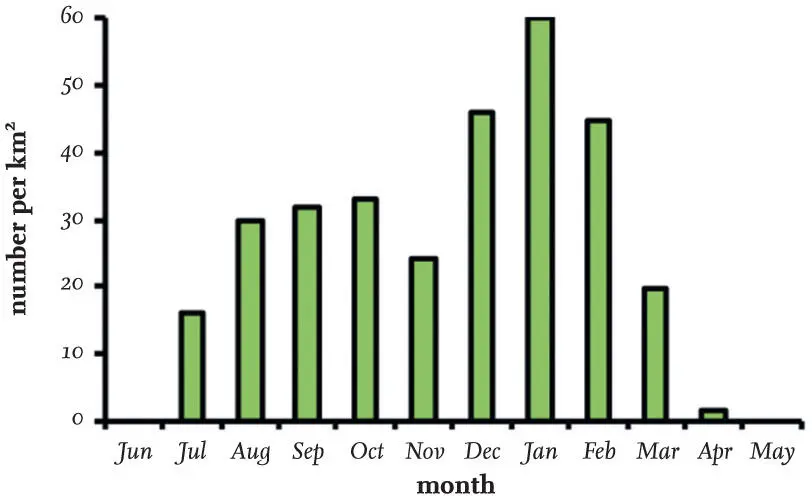DISTRIBUTION AND HABITATS
The Black-headed Gull is widely distributed in Europe and breeds across Asia, and there is no evidence of subspecies within this large range. The species extended its western range in the twentieth century, reaching the Faeroes early on at an unrecorded date, Iceland in 1910 (50,000 adults now breed there) and Greenland in 1969. Breeding in North America was suspected as early as 1963 but not proven until 1977, when nesting by 14 pairs was recorded in Newfoundland. More recently, breeding has been suspected at other sites in North America, with recently fledged young being reported at several locations from Labrador to Massachusetts. Several young birds ringed in Iceland have been recovered during winter in Newfoundland and Labrador, but only one ringed individual of this species is known to have crossed from the mainland of Europe to the New World. It was ringed in the Netherlands and recovered 200 km off the coast of Labrador, so it seems likely that those seen in North America are mainly individuals reared in Greenland and Iceland.
Movement to North America has progressed in a series of stages rather by a sudden irruptive transatlantic movement from Europe, with birds breeding or reared in the Faeroes, Iceland and Greenland gradually moving west. This spread, together with a northern movement in Norway, Sweden and Finland, has been interpreted as a response to climate change. However, this theory ignores the spread of breeding to Italy (1960) and Spain (1960), and the fact that the increase within the species’ core area in Europe during the twentieth century has probably been mainly responsible for the spread of the western limits of its breeding distribution.
Today, unknown numbers of Black-headed Gulls nest across Asia and some 4 million to 5 million adults breed in Europe, of which about 250,000 nest in Britain and Ireland. Those breeding here probably represent less than 5 per cent percent of the world population.
The Black-headed Gull is the commonest gull frequenting sports fields, landfill sites, harbours and areas around large shopping complexes, and the birds also seek food in urban streets, domestic gardens and even at bird tables during severe winter weather. In many areas, they are also the gull most likely to be seen following the plough in agricultural fields. The species achieved fame in literature as the character Kehaar in the well-known book Watership Down, written by Richard Adams (1972). Kehaar suffered a damaged wing and took refuge at Watership Down, eventually recovering and returning to his colony.
Numbers of Black-headed Gulls in and around towns and cities can be high, particularly in winter, but this has not always been the case. For example, until the end of the nineteenth century the species was considered scarce in central London, but the birds are now present here in their thousands in winter, where they are abundant in parks, sports fields, lakes and the river Thames, often seen competing vigorously for scraps of food.
The gathering of flocks of Black-headed Gulls around towns and cities varies through the year. Fig. 16shows their density month by month within a radius of 5 km of Durham, where many were recorded on sports fields, pastures and the river Wear running through the city centre, or patrolling streets and shopping centres in search of discarded food. The gulls retreated to their colonies in March, and since none of these was within 40 km of the city, only an occasional immature bird was recorded in April and none of any age in May and June. There are many accounts of Black-headed Gulls frequenting other areas in winter and being absent there in spring and summer. It is obvious that the distribution of the birds in Britain becomes much more clumped during the breeding season and is limited by feeding range from colonies. At most colonies, first-year (non-breeding) Black-headed Gulls are also infrequent and those that are encountered are seen feeding with adults well away from colonies, commonly on intertidal estuaries.

FIG 16. The seasonal variation in the numbers of Black-headed Gulls within a radius of 5 km of the city of Durham between 1982 and 1984, and in the absence of local breeding colonies. In each year, the gulls were absent in May and June, and the first individuals arrived in July, coinciding with the Durham Miners’ Gala, when a considerable amount of food was dropped by the large numbers of people attending the event. Based on data collected by MacKinnon (1986).
HISTORICAL BREEDING STATUS IN BRITAIN AND IRELAND
The status of the Black-headed Gull in Britain and Ireland in or before the twentieth century is not clear owing to a lack of detailed information. On its website, the British Trust for Ornithology ( www.bto.org) says that the species was a rare breeding bird in Britain in the nineteenth century, and the statement made by John Gurney Jr in 1919 that the species was in danger of extinction here cannot be true. Both opinions lack supporting evidence and are contradicted by the extensive egg collecting that occurred at that time ( here), and by the historical evidence accumulated by Michael Shrubb in his book Feasting, Fowling and Feathers – a History of the Exploitation of Wild Birds (2013). It is likely that the movement of colonies was misinterpreted as a decline in numbers, and that the ‘disappearances’ of the birds were probably movements of adults elsewhere and the establishment of new colonies in response to nest predation. Such movements of colonies are also frequent, and better known, in the Little Tern (Sternula albifrons), where they are closely related to poor breeding success induced by predators or by human disturbance.
There can be little doubt that the numbers of Black-headed Gulls breeding in Britain increased in the period between 1900 and 1973, as did those of many other gull species breeding here. However, Black-headed Gulls are not easy to count accurately. Colonies of very varying sizes occur both on coasts and inland, and the latter are often particularly difficult to count, with nesting taking place in marshes, on islands in lakes and tarns, and sometimes among tall or floating vegetation in boggy areas. In addition, colonies on moorland are often small and scattered, and new ones can remain overlooked for some time.
The first census of Black-headed Gulls in England and Wales was made in 1938, with further surveys in 1958 and 1973. The report of the census made in 1973 concluded that there were between 200,000 and 220,000 breeding adults, and that since 1938 there had been an increase of 177 per cent, while the number of colonies containing more than 2,000 adults had doubled since 1958. However, part of the reported increase might be attributed to a better coverage of colonies in 1973. In Scotland, a census made in 1958 suggested that there had been little recent change in abundance, but that numbers had continued to be influenced by uncontrolled egg collecting. The national censuses of Britain and Ireland in 1970 and 1985 counted only coastal-nesting Black-headed Gulls and did not consider the appreciable numbers nesting inland. The census in 2000 included inland colonies for the first time and resulted in an estimate of about 336,000 breeding adults in Britain and Ireland, of which 44 per cent were nesting inland.

FIG 17. Map of the breeding distribution of the Black-headed Gull in Britain and Ireland in 2008–11. Reproduced from Bird Atlas 2007–11 (Balmer et al., 2013), which was a joint project between the British Trust for Ornithology, BirdWatch Ireland and the Scottish Ornithologists’ Club. Channel Islands are displaced to the bottom left corner. Map reproduced with permission from the British Trust for Ornithology.
Читать дальше














